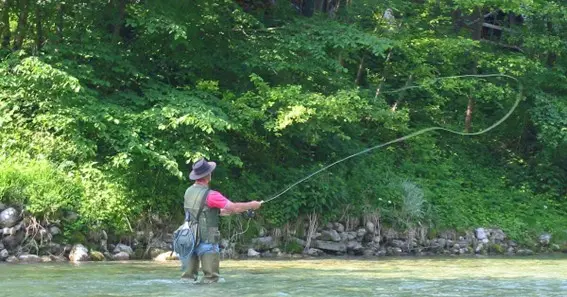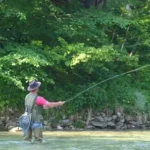Fly fishing is a beloved sport with rich traditions in both Britain and the United States, but British vs American fly fishing presents distinct approaches shaped by geography, culture, and history. Each region has developed unique styles, techniques, and preferences that make fly fishing experiences in these countries quite different.
Techniques and Styles
British Fly Fishing Techniques: In the UK, fly fishing has a long history tied to traditional methods. British anglers often prioritize finesse and accuracy, favoring techniques like dry fly fishing, where the fly remains on the water’s surface. This method is particularly favored in Britain’s renowned chalk streams, like the River Test, known for their clear and calm waters. Another common British practice is upstream nymphing, which requires delicate, precise casting to simulate the behavior of insects drifting naturally with the current.
American Fly Fishing Techniques: In the U.S., fly fishing has evolved to accommodate diverse environments—from the serene rivers of the Northeast to the wide, wind-swept streams of the American West. Techniques like wet fly fishing are more popular in the U.S., where the fly sinks below the water’s surface, imitating submerged insects. Americans are also known for using streamers, a method designed to attract fish by mimicking baitfish or other aquatic prey. Techniques such as Euro nymphing, adapted from Europe, have also gained popularity for targeting fish in faster currents.
Gear and Equipment
British and American fly fishing gear reflects the conditions of local waters. In Britain, fly rods tend to be shorter and lighter, suitable for the smaller, controlled casts required in clear and narrow rivers. British anglers often prefer natural-looking flies, emphasizing subtlety and tradition in their choice of patterns.
Conversely, American fly fishing rods are generally longer and sturdier, built for longer casts and handling larger fish. Flies used in the U.S. are often flashier and more colorful, designed to attract fish in murkier or more turbulent waters. In terms of reels, British anglers opt for simpler designs focusing on finesse, while American anglers prefer robust reels with advanced drag systems for battling bigger game.
Fish Species and Target Environments
British Angling: British fly fishing is predominantly centered around trout and salmon. The country’s rivers and streams, often clear and calm, are ideal for targeting species like brown trout, rainbow trout, and Atlantic salmon. The practice of dividing fish into “game” and “coarse” categories also shapes British angling traditions.
American Angling: In the U.S., the scope of fly fishing is broader. In addition to trout and salmon, American anglers pursue a variety of species, including bass, steelhead, and even saltwater fish like bonefish and tarpon. This diversity in target species is partly due to the vast and varied American landscape, which offers everything from mountain streams to expansive lakes and coastal waters.
Culture and Etiquette
In Britain, fly fishing carries a sense of tradition and decorum. Anglers often adhere to unwritten rules, maintaining a respectful distance from each other and dressing in muted tones that blend with the environment. In contrast, American fly fishing is marked by a spirit of adventure and exploration, with less emphasis on formalities. Anglers in the U.S. frequently seek out remote locations and enjoy a more relaxed approach to the sport.
Conservation and Access
Both countries have embraced catch-and-release practices to preserve fish populations, but the methods and regulations differ. In Britain, many of the prime fishing locations are privately owned, requiring permits or memberships for access. In contrast, much of America’s top fishing spots are public lands, offering open access to anglers willing to explore.
FAQ
1. What is the main difference between British and American fly fishing techniques?
British fly fishing often emphasizes dry fly techniques and precision, while American styles include a broader range of methods, including wet fly fishing and streamer use.
2. Are there specific types of gear unique to British or American fly fishing?
British anglers favor lighter, more traditional rods and subtle, natural-looking flies. American gear includes longer rods, robust reels, and often brighter, flashier fly patterns.
3. How does the target fish species differ between the UK and the U.S.?
In Britain, fly fishing typically targets trout and salmon. In the U.S., the variety is broader, including not only trout and salmon but also bass and saltwater species.
4. What are some famous fly fishing destinations in each country?
Britain’s River Test and the Scottish Highlands are renowned for their fly fishing. In the U.S., rivers like the Madison in Montana and the Yellowstone are top choices.
5. How do British and American anglers differ in their approach to conservation?
Catch-and-release is practiced in both regions, but British waters often require permits for access, whereas many American fishing spots are public.
Exploring the world of British vs American fly fishing provides a window into the unique and evolving traditions of this timeless sport, reflecting the landscapes and cultures of each region.










